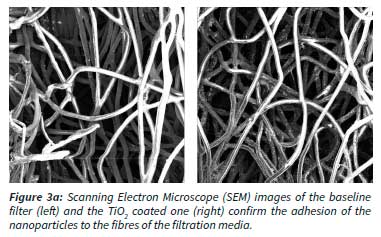Services on Demand
Article
Indicators
Related links
-
 Cited by Google
Cited by Google -
 Similars in Google
Similars in Google
Share
Clean Air Journal
On-line version ISSN 2410-972X
Print version ISSN 1017-1703
Clean Air J. vol.32 n.1 Pretoria 2022
http://dx.doi.org/10.17159/caj/2022/32/1.11389
RESEARCH ARTICLE
Air pollution abatement by selective nanoparticle deposition on filtration systems
Ishika Nag
Seminole State College, Sanford, FL, 32765 USA
ABSTRACT
Air pollution kills an estimated seven million people worldwide every year. The data from the World Health Organization (WHO) shows that almost all the global population (99%) breathe air that exceeds WHO guideline limits. The growing population and urbanization such as in Africa, which has the fastest growing population, may lead to substantial worsening of the air quality. Urbanization is also a powerful driver of the epidemiologic transition from traditional threats like infectious diseases and malnutrition to chronic, non-communicable diseases. Particulate matter less than 2.5 microns in size, PM25, is the leading contributor to air pollution which results in such diseases like chronic obstructive pulmonary disease (COPD), bronchitis, and lung cancer. Recent studies have shown a strong correlation between ambient air pollution and COVID-19 cases, which has affected the lives of billions of people around the world. Abatement technologies such as ionic and other high efficiency filtration systems are quite expensive and hence unaffordable to communities with limited resources. The goal of this study was to develop an air pollution filtration method utilizing selective nanoparticle deposition in optimized concentrations, to maximize the entrapment of PM2.5 particles. The experimental set-up consisted of a wind tunnel with incense sticks as the PM25 source, measured by laser particle detectors upstream and downstream of the filters. Different nanoparticle coated filters were tested using the 'Design of Experiments' methodology and it was concluded that an optimized mixture of zinc oxide, titanium dioxide & graphene improved filtration efficiency of a baseline filter by 206% and was 70% cheaper than high efficiency filters. The versatility and cost-effectiveness of this design makes it applicable for personal masks & filters, air-conditioning and car-cabin filters, and fire-fighting equipment. The significant correlation between air pollution and fatalities from viral infections like COVID-19, makes such abatement technologies with innovative filtration systems critical to save human lives.
Keywords: Air Pollution, Filtration, Nanoparticle, Particulate Matter, PM25
Introduction
Air pollution is the contamination of the air in the atmosphere by a physical, biological or chemical alteration. Particulate matter (PM) is one of the main contributors to air pollution, consisting of a mixture of solid and liquid particles suspended in the air. The most used health indicator related to PM refers to the mass concentration of particles with a diameter less than 2.5μm, PM25 (Nolt-Helms et. al. 2018; Francesca et. al. 2006). Primary sources of PM2.5 include anthropogenic sources such as automobile emissions, household fuel (Matawle et. al. 2017) and waste burning, energy production from fossil fuels (Kundu and Stone, 2014) and biomass, and industrial activities such as construction, mining, cement production, etc. 50% of the total PM emissions in urban areas is generated from traffic (Wrobel et. al. 2000). The most polluted areas around the world tend to be in developing countries in Africa, South-East Asia, India and China, due to their increased density of urban population, significant use of fossil fuels and relatively inadequate control measures and filtration systems (World Health Organization, WHO, 2022).
Africa has the fastest growing population in the world, predicted to surpass two billion by 2050 (UN 2011). Half of Africa's population is expected to live in urban areas by 2035, and Sub-Saharan Africa will host five of the world's 41 megacities by 2030 (Katoto et. al. 2019). Urbanization and increased industrialization, growing ownership of automobiles, and continued use of biomass as domestic energy source may lead to substantial worsening of air quality across the continent (Petkova et. al. 2013). Urbanization is also a powerful driver of the global demographic and epidemiologic transition, characterized by declining birth rates, increasing life expectancy, and a shift from traditional threats such as infectious diseases and malnutrition to chronic, non-communicable diseases like heart disease and diabetes (Omran 1971).
Almost all (99%) of the world's population lives in places exceeding WHO's air quality guidelines and 7 million people die every year because of air pollution (World Health Organization, WHO, 2022). The primary causes of such premature deaths are chronic obstructive pulmonary disease, heart disease, stroke, lung cancer and acute respiratory infections in children. PM2.5, due to its small size, is capable of penetrating deep into lung passageways and entering the bloodstream causing cardiovascular, cerebro-vascular, and respiratory impacts (Vijayan et. al. 2015; Xing et. al. 2016). Furthermore, long term exposure to air pollution has been found to increase the vulnerability to the most severe impacts of coronavirus outbreaks such as SARS in 2003 and COVID-19 in 2020 (Coker et. al. 2020; Comunian et. al. 2020; Zoran et. al. 2020; Wu et. al. 2020). An increase of only 1 μg/m3 in PM2.5 is associated with an 8% increase in the COVID-19 death rate in the United States (Wu et. al. 2020).
Indirect effects of ambient air pollution include acid rain caused by excessive amounts of sulphur oxides in the air. This can impact aquatic ecosystems, as well as man-made landscapes (Bhargava and Bhargava 2013; Banerjee and Sarkar 2019). Photochemical smog caused by the combination of nitrogen oxides and PM2.5 can harm the ozone layer which in turn results in global warming and its associated social, economic, and geopolitical consequences (Davidson 2015).
Abatement technologies such as ionic and High Efficiency Particulate Air (HEPA) air filtration systems (Abatement Technologies, 2018) have been developed that can filter PM2.5 particles significantly but remain quite expensive and hence unaffordable to communities with limited resources (Vyas et. al. 2016; Brook 2019). Therefore, a cost-effective and efficient abatement system is essential in helping to resolve the issue.
Nanoparticles have a high surface to volume ratio, which enhances the entrapment of particulate matter by adsorption. The surface adsorption energy is unique to the small size of nanoparticles with extremely high surface to volume ratios, where the unsaturated surface chemical bonds tend to adsorb other chemicals or biomolecules to reduce their surface energy (Xia et. al. 2011). The three nanoparticles used for this study were graphene, titanium dioxide (TiO2), and zinc oxide (ZnO), which have been known to have filtration properties due to their high adsorption capabilities (Zhong et. al. 2015; Wongwatcharapaiboon et. al. 2019; Ruan et. al. 2020). Graphene, an allotrope of carbon consisting of a single layer of carbon atoms arranged in a hexagonal lattice structure, has high adsorption capacities mainly due to these unique nanostructures, and hence has been proven to be efficient in the capture of particulate matter (Szcze_sniak 2017; Zhang et. al. 2018). TiO2 nanoparticles, with their photocatalytic properties, absorb the ultraviolet component of sunlight and act as a catalyst to form reactive hydroxyl (*OH) radicals and the superoxide anion (O2«-) from atmospheric moisture and oxygen. These radicals react with the PM2.5 particles due to their strong oxidizing capabilities converting them into CO2 and H2O (Giovanetti et. al. 2017), hence have been used for air purification (Thanh Son Le et. al. 2015).
The current work is aimed to develop an efficient and cost-effective air-filtration system by the deposition of nanoparticles on a readily available filtration media. The nanoparticles are selected based on their air filtration capabilities, clinical safety, and non-toxicity. The filtration system needs to be versatile and effective at different pollution levels in different parts of the world and from different pollutant sources, as described above. The goal of this work is to also develop a simple application technique of the nanoparticles such that it can be easily applied to various filtration systems in different parts of the world, thus providing an affordable alternative to expensive high quality air filtration devices with comparable air filtration capabilities.
Materials and methods
Experimental set-up
A wind tunnel was designed and created to test the efficiency of the filters (Fig. 1), as a continuation of a previous study (Nag, 2021-22). A cardboard box (142x50x50 cm) was used as the body of the tunnel. A washer-dryer exhaust tube (diameter 10 cm) was used to connect the PM source to the inlet section of the tunnel. Incense sticks were used as the source of PM2.5 (Lui et. al. 2016; Jilla and Kura 2017). A fan (Lasko, 50x50 cm) was placed on the inside of the tunnel to blow the PM2.5 through the filter, which was placed downstream of the fan. PM2.5 detectors (Temtop LKC-1000S) were hung inside the inlet and outlet sections of the wind tunnel, and plexiglass windows were installed into the tunnel for visualization of the detector readings. A manometer (PerfectPrime AR1890P2) was used to measure pressure drop, with the tubes placed upstream and downstream of the fan and filter; and a lamp (Hyperikon, 15W, 5000K) was used to simulate the effect of daylight to enhance the photocatalytic properties of the TiO2-coated filters.

Nanoparticle deposition
The nanoparticles used for this study were Titanium Oxide (TiO2 Anatase, 99.5% 40nm, US Research Nanomaterials, Inc.), Zinc Oxide (ZnO, 99+%, 35-45 nm, US Research Nanomaterials, Inc.) and Graphene (Alfa Aesar™ Graphene nanoplatelets aggregates, 500 m2/g, Fisher-Scientific).
The combination of nanoparticles was mixed with ethanol (200 Proof (100%), USP/EP/ACS, Fisher-Scientific) to create a suspension which appears as a slurry. This suspension was then aerosolized using the pressurized sprayer system (Preval Airless Paint Sprayer, 70 psi, Home Depot), and the aerosolized spray was directed towards a typical Heating, Ventilation and Air Conditioning (HVAC) air filter (Rheem, 51x51x2.5 cm, wire-backed pleated fiberglass and paper media) with a Minimum Efficiency Reporting Value (MERV) rating of 8 (ASHRAE, 2020) while maintaining a spray-distance of about 15-18 cm. The filters were then air-dried for at least 8 hours and then tested for efficacy. A 'high quality' air filter (Rheem, 51x51x2.5 cm, MERV-14, Home Depot) was used for comparison and benchmarking the filtration efficiency.
Different combinations (Fig 4.) and concentrations (Fig. 7) of nanoparticles were experimented with, to determine the optimized mixture to maximize filtration efficiency. The nanoparticle loading was calculated at 2.33E-04 g/cm2 for 2% coating with one nanoparticle, and at 4.65E-04 g/cm2 for 2% coating with two nanoparticles. The maximum loading was 2.79E-03 g/cm2 for the 8% coating with all three nanoparticles.





Spatial uniformity of nanoparticle deposition
The deposition method of nanoparticles onto the filtration media were also varied and tested for uniform spatial distribution as in the previous study by the same author (Nag, 2021-22). Different spray mechanisms were tested using pipettes, spray bottles and pressurized sprayers. Different zones of the air filter, in 9 locations, were tested for spatial variation in filtration efficiency (Fig. 2). The pressurized spray application resulted in the most uniform spatial distribution of the nanoparticles and was chosen as the preferred application method for its simplicity and effectiveness.
Surface morphology of coated filters
The surface morphology of the filters was characterized using the scanning electron microscope (SEM) imaging technique and confirmed the adhesion of the nanoparticles. A Zeiss Ultra-55 SEM with a Schottky field emission source and resolution of 1 nm @ 15 KV, 1.7 nm @ 1 KV was used. The images below are at 100X magnification. These SEM images (Fig. 3a) of the filters enabled the confirmation of the nanoparticle adhesion to the filters in the coated filters as compared to the baseline (uncoated). The entrapment of particulate matter onto the nanoparticle surfaces in the 'after' images of the different nanoparticle coated filters are visualized in the SEM images (Fig. 3b), as previously reported (Nag, 2022). The embedded nanoparticles enhance the diffusion and electrostatic attraction mechanisms of filtration due to high surface to volume ratio and photocatalytic activation properties (N95 Respirators and Surgical Masks, CDC, 2009).
Design of experiments
A Design of Experiments (DOE) statistical analysis model helps with analysing and interpreting test results and the effects of multiple input variables and their interactions on an output variable (Minitab, 2020). A full factorial DOE design was used to collect and analyse the data to randomize the run order of the experiment, minimize bias and aid with the Analysis of Variance (ANOVA) study. Combinations of single nanoparticles (Graphene or ZnO or TiO2), combination of two nanoparticles and finally all three together were experimented in a random order, as shown in Fig. 4.
The PM25 at the inlet was also varied significantly to test the versatility of the filters over different environmental conditions. The lower end of the inlet PM25 at 80~100 μg/m3 represents pollution levels in typical polluted cities in India and China. The mid-level at 150~200 μg/m3 represents some polluted cities in Egypt and Niger, while the higher end at 250~300 μg/m3 represents forest fires, heavy vehicle exhausts and smoke.
Validation of experimental results
To validate the results from this experiment, commercially available 'high quality' filters were tested in this set-up and compared to previously performed studies. HVAC filters rated with a Minimum Efficiency Reporting Value (MERV) of 14 (ASHRAE, 2020) were tested using this wind tunnel experimental set-up over several days as shown in Fig. 5 and were found to be consistent and comparable to a previous study (Zhao et. al. 2015) using MERV 14 (equivalent to 'Filter Performance Rating' FPR 10) type filters, thus confirming the accuracy of the experimental set-up.
Measurement uncertainty
A statistical repeatability and reproducibility study (Gage R&R) was used using Minitab software (Minitab, 2020), to determine the measurement uncertainty of the experiment. The tests were repeated for 10 trials each and repeated over different days to measure repeatability and reproducibility. It was seen (Fig. 6) that 95% of the contribution was from 'part-to-part variation' (natural variability due to different parts) and 5% from the measurement process variation (variability due to measurement system uncertainties), which is deemed to be an acceptable measurement uncertainty, per statistical guidelines (Automotive Industry Action Group (AIAG), 2010). The reproducibility factor of this experiment (experiments conducted over different days) is very high since the uncertainty from the reproducibility is almost negligible.
Other sources of uncertainty
Sources of the remaining measurement uncertainty may include the calibration of the PM2.5 detectors which may affect their absolute measurements, which can be improved by performing calibrations with mixtures of known PM2.5 concentrations. The generation of PM2.5 particles from incense sticks was inconsistent and may have also contributed to the measurement system uncertainty of the experiment. The sealing system (using insulation sealing materials) between the inlet and outlet sections of the wind-tunnel may have been another source of uncertainty.
Results and discussion
As explained in section 2.2, different concentrations and combinations of nanoparticles were evaluated for maximizing filtration efficiency. The results showed (Fig. 7) that the concentration of nanoparticles has a direct correlation to the filtration efficiency (1). The correlation between nanoparticle type and filtration efficiency was also observed, with titanium dioxide coated filters demonstrating the highest efficiency. The mixture of nanoparticles was more effective in reducing PM2.5 as compared to the individual nanoparticles.

The interaction plots from the ANOVA analysis (Fig. 8) indicate that although the main effects of the individual nanoparticles were significant, there was strong interaction between Graphene and TiO2 and ZnO and TiO2. However, the interaction between Graphene and ZnO was not as significant. Hence, it can be ascertained that TiO2 has a key interaction effect and improves the efficiency of the other nanoparticles (ZnO and Graphene) in its presence.

The titanium dioxide coated filters had a 7% increase in filtration efficiency when placed under light, due to the activation of its photocatalytic properties. TiO2 nanoparticles (NP), with their photocatalytic properties, absorb the ultraviolet component of sunlight which excites the electrons (e-) from Valence Band (VB) to Conduction Band (CB) and act as a catalyst to form the superoxide anion (O2«-) and reactive hydroxyl (OH«) radicals from atmospheric moisture and oxygen (2). These radicals react with the PM2.5 particles due to their strong oxidizing capabilities converting them into CO2 and H2O (Giovanetti et al. 2017).

Although this mechanism is applicable to organic sources of PM2.5, this author has also further evaluated the consistency of the filtration efficiency from different sources of PM2.5 (Nag, 2022). Most of the PM2.5 generated is from organic compounds such as fossil fuels and wood-burning (WHO, 2020).
A two-sample t-test (Fig. 9) with 95% confidence intervals, indicates the marked improvement of filtration efficiency with the application of light (p-value <0.05).

A significant parameter that affects the filtration system's energy consumption is its pressure drop. Pressure drop can be calculated by using the Bernoulli equation (3):

where P is the pressure, ρ is the density of the fluid, ν is the velocity, g is the gravitational acceleration, h is the height, subscript1 denotes upstream conditions and subscript2 is for downstream conditions. Under steady, incompressible, and frictionless flow along a streamline assumption with the same horizontal height; (3) can be simplified to the pressure drop equation (4):

A quantitative test of airflow was conducted by measuring the pressure drop (Δp) across the filter. As seen in Fig. 10, the pressure-drop (psi) was consistent across the baseline and the nanoparticle coated filters. This is because the size of these nanoparticles is considerably smaller (60-80 nm) than the size of the fibres in the filter (3-5 μm). This indicates that applying the nanoparticles to the air filters does not affect their energy consumption in a measurable way.

An accelerated durability testing (5) was performed to test the effectiveness of the filters over longer usage periods. The durability testing was accelerated by increasing the volume flow rate of air by increasing the fan speed, and the mass flow rate of PM2.5 was increased by increasing the incense stick count.
The samples were tested intermittently to monitor the decrease in filtration efficiency over time. It was seen that 90% of the filter's effectiveness was maintained after 50 equivalent operational days and 70% of its initial efficiency is maintained over 100 equivalent days of operation (Fig. 11).
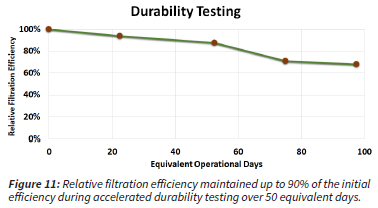
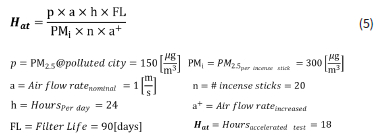
The nanoparticle coatings consistently demonstrated the ability to improve the filtration efficiency of a baseline filter (Fig. 12). The filters with single nanoparticle coatings (NP=1) with Graphene, ZnO or TiO2, demonstrated an improvement of about 100% over the baseline uncoated filter. Coating the filters with two out of these three nanoparticles (NP=2) improved the efficiency further. However, the filter coated with a mixture of all three-nanoparticles (NP=3), had the highest filtration efficiency which was 3 times higher than the baseline filter. The filtration efficiency of this filter, at 77%, was quite comparable to the more expensive 'high-quality' MERV-14 filters. The filter coated with TiO2 alone was also quite effective, but less versatile due to its dependence on light for activation of its photocatalytic properties.
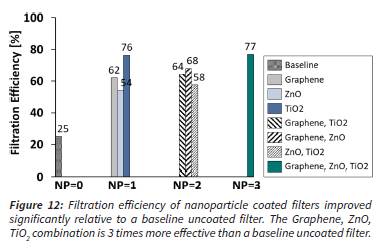
Cost-effectiveness was one of the main objectives of this experiment (Fig. 13) to make this technology available to societies with limited resources. Considering the baseline cost of a commercially available filter and the additional cost of nanoparticles and processing, the nanoparticle coated filters were 70% cheaper than the HEPA filters, and 99% cheaper than ionic filters. The cost assumptions behind this calculation are based on commercially available filters in a local hardware store. A regular air-conditioning filter with filter performance rating (FPR) 4 (equivalent to MERV 6/7) is considered as "baseline", priced at ~$4. The nanoparticle coating content in each filter is approximately 2.5 g (8% concentration wt./wt.) at an average cost of ~$400/kg thus a weighted total price of ~$3 for the 3 nanoparticles. The processing cost of $1 is assumed for consumables and labour. The FPR 10 (MERV equivalent 14) is the commercially available HEPA filter of the same size, priced at ~$25 and an ionic filtration system is commercially available for ~$500.

The nanoparticle coated filters were also tested for their versatility at different inlet conditions and compared to the PM2.5 pollution levels in different parts of the world and from different sources. In a further study, the filtration efficiency has been found to be consistent across different sources of PM2.5, such as wood chips, paraffin and incense (Nag, 2022).
As illustrated in Fig. 14, the bar-chart indicates the PM2.5 pollution levels found in different countries (2019 World Air Quality Report) like China, India, Niger etc. and from different pollutant sources (De Marco et. al. 2016) like wildfires, emissions from trucks etc. Typically, the PM2.5 levels in countries like Niger are about 200 μg/m3 or in India about 80 μg/m3. The PM2.5 levels from wildfires and emissions from trucks are in the range of 250-270 μg/m3. The results of the filtration efficiency of the nanoparticle coated filters are plotted on the same graph relative to the inlet PM2.5 conditions simulating the levels of pollution in different countries and from different sources. It can be seen in Fig. 14, that the filtration efficiency is relative consistent between 7080% irrespective of the inlet levels of PM2.5. This indicates that the nanoparticle coated filters are versatile in their usability -from different sources and levels of PM2.5 pollution.
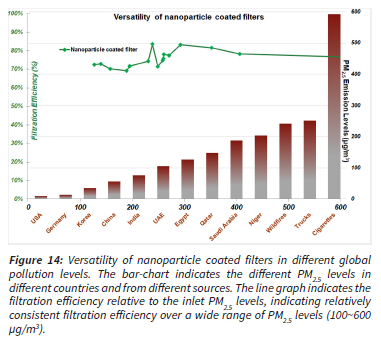
The safety of nanoparticle usage is of utmost importance and continues to be a subject of research worldwide. The nanoparticles chosen for this study are known for their clinical safety and non-toxicity. TiO2, ZnO and Graphene are extensively used in commercial products like pill coatings, sunscreens, and biomedical applications (Shi et. al. 2015; Arvidsson 2018).
Conclusion
The results of this experiment can be used in several applications including personal protective equipment like air pollution masks, air-conditioning and car cabin filters, firefighting equipment, and industrial pollution control systems for power plants, incinerators, or automobiles. The versatility and effectiveness of this filtration system makes it applicable in different parts of the world with varying pollution levels. The simplicity of the application method and the cost-effectiveness make this process feasible to be used in low-income areas that have higher risks of air pollution and limited resources to combat their lethal effects. The nanoparticles selected for this application have been known for their non-toxicity and hence safe for human use. A significant correlation has been found between ambient air pollution and deaths caused by viral infections, such as COVID-19, which lead to respiratory diseases. This makes it essential for individuals to reduce their own pollution footprint, especially in rapidly urbanizing areas of the world, and adapt such novel, cost-effective and safe nanoparticle coated filtration technologies to reduce the deadly consequences of air pollution.
Acknowledgments
The author thanks the Nanotechnology centre at the University of Central Florida for the support and the facilities provided, Dr. Yang Yang (University of Central Florida) for his mentorship and his research assistant Guanzhi Wang for her support with coating filters in the laboratory, and Mr. William Furiosi (Oviedo High School) for his guidance and access to the laboratory for testing.
References
"Abatement Technologies. Facts about true HEPA filtration", https://www.abatement.com/learning-center/patient-isolation/facts-about-hepa-filtration/, 2018. [ Links ]
2019 World Air Quality Report Region and City PM25 Ranking. https://www.iqair.com/world-most-polluted-cities/world-air-quality-report-2019-en.pdf [ Links ]
Arvidsson, R., Boholm, M., & Montoya, L. D., "Just carbon: Ideas about graphene risks by graphene researchers and advisors", Nanoethics, 12(3), 199-210, 2018. DOI: 10.1007/s11569-018-0324-y ASHRAE, American Society of Heating, Refrigerating and AirConditioning Engineers (ASHRAE), 2020. https://www.ashrae.org/technical-resources/filtration-and-disinfection-faq [ Links ]
Automotive Industry Action Group (AIAG), "Measurement systems analysis reference manual, 4th edition", Chrysler, Ford, General Motors Supplier Quality Requirements Task Force, 2010. [ Links ]
Banerjee, D., Sarkar, S., "Chemical and biochemical onslaught of anthropogenic airborne species on the heritage monument of the Taj Mahal", Heritage, 2(3), 2137-2159, 2019. https://doi.org/10.3390/heritage2030129 [ Links ]
Bhargava, S., Bhargava, S., "Ecological Consequences of The Acid Rain", IOSR Journal of Applied Chemistry (IOSR-JAC), e-ISSN: 2278-5736.5(4), PP 19-24, 2013. DOI:10.9790/5736-0541924 [ Links ]
Brook, D., "What is an air ionizer? Are air ionizers good for you?", https://breathequality.com/ionizer/ (2019). [ Links ]
Coker, E. et. al., "The Effects of Air Pollution on COVID-19 Related Mortality in Northern Italy", Environ Resour Econ (Dordr), 2020 Aug 4: 1-24. doi: 10.1007/s10640-020-00486-1 [ Links ]
Comunian, S., et. al., "Air Pollution and COVID-19: The Role of Particulate Matter in the Spread and Increase of COVID-19's Morbidity and Mortality", Int J Environ Res Public Health, 2020 Jun; 17(12): 4487. doi: 10.3390/ijerph17124487 [ Links ]
Davidson, A., "Photochemical oxidant air pollution: a historical perspective", Studies in Environmental Science, 72(1), 393-405, 1998. [ Links ]
De Marco, C., Ruprecht, A.A., Pozzi, P. et al. Particulate matters from diesel heavy duty trucks exhaust versus cigarettes emissions: a new educational antismoking instrument. Multidiscip Respir Med 11, 2 (2016). https://doi.org/10.1186/s40248-016-0042-7 [ Links ]
Francesca Dominici, F., Peng, R., Bell, M., Pham, L., McDermott, A., Zeger, S., Samet, J., "Fine Particulate Air Pollution and Hospital Admission for Cardiovascular and Respiratory Diseases", JAMA, 295(10), 2006. doi:10.1001/jama.295.10.1127 [ Links ]
Giovanetti, R., Rommozzi, E., Zannotti, M., & D'Amato, C. A., "Recent advances in graphene based TiO2 nanocomposites (GTiO2Ns) for photocatalytic degradation of synthetic dyes", Catalysts, 7(10), 305, 2017. doi:10.3390/catal7100305 [ Links ]
Jilla, A., Kura, B., "Particulate matter and carbon monoxide emission factors from incense burning", Environmental Pollution Climate Change, 1(4), 2017. doi: 10.4172/2573-458X.1000140 [ Links ]
Katoto PDMC, Byamungu L, Brand AS, Mokaya J, Strijdom H, Goswami N, De Boever P, Nawrot TS, Nemery B. Ambient air pollution and health in Sub-Saharan Africa: Current evidence, perspectives and a call to action. Environ Res. 2019 Jun;173:174-188. doi: 10.1016/j.envres.2019.03.029 [ Links ]
Kundu, S., Stone, E., "Composition and sources of fine particulate matter across urban and rural sites in the Midwestern United States", Environ. Sci.: Processes Impacts, 16, 1360-1370, 2014. doi: 10.1039/c3em00719g [ Links ]
Lui, K H, et.al., "Characterization of chemical components and bioreactivity of fine particulate matter (PM2.5) during incense burning", Environmental Pollution, ISSN: 0269-7491, 213, 524532. https://doi.org/10.1016/j.envpol.2016.02.053 [ Links ]
Matawle, J.L., Pervez, S., Shrivastava, A. et al., "PM2.5 pollution from household solid fuel burning practices in central India:1. Impact on indoor air quality and associated health risks", Environ Geochem Health 39,1045-1058. https://doi.org/10.1007/s10653-016-9871-8, 2017. [ Links ]
Minitab 20 Statistical Software (2020). [Computer software]. State College, PA: Minitab, Inc. (www.minitab.com) [ Links ]
N95 Respirators and Surgical Masks, CDC, 2009. https://blogs.cdc.gov/niosh-science-blog/2009/10/14/n95/ [ Links ]
Nag, I. (2021-22). Enhancing Efficacy and Cost Effectiveness of Air Filtration Systems by Optimized Nanoparticle Deposition. Columbia Junior Science Journal. http://cjsjournal.org/s/Ishika-Nag-Article-164.pdf [ Links ]
Nag, I. (2022). Development of a combinatory filtration system for pollution and virus abatement. PLOS ONE 7(22): e0264991. https://doi.org/10.1371/journal.pone.0264991 [ Links ]
Nolt-Helms, C., M. Breville., "Environmental Public Health Indicators Impact Report: Data and methods that support environmental public health decision-making by communities," U.S. Environmental Protection Agency, Washington, DC, EPA/600/X-18/163, 2018. [ Links ]
Omran AR (1971) The epidemiological transition: a theory of the epidemiology of population change. Milbank Memorial Fund Q49(4):509-538. doi: 10.1111/j.1468-0009.2005.00398.x [ Links ]
Petkova, E.P., Jack, D.W., Volavka-Close, N.H. et al. Particulate matter pollution in African cities. Air Qual Atmos Health 6, 603614 (2013). https://doi.org/10.1007/s11869-013-0199-6 [ Links ]
Ruan, D., Qin, L., Chen, R. et al., "Transparent PAN:TiO2 and PAN-co-PMA:TiO2 Nanofiber Composite Membranes with High Efficiency in Particulate Matter Pollutants Filtration", Nanoscale Res Lett., 15, 7. https://doi.org/10.1186/s11671-019-3225-2. [ Links ]
Shi, H., Magaye, R., Castranova, V. et al. Titanium dioxide nanoparticles: a review of current toxicological data. Part Fibre Toxicol 10, 15 (2013). https://doi.org/10.1186/1743-8977-10-15. [ Links ]
Szczesniak, B., Choma, J., & Jaroniec, M., "Gas adsorption properties of graphene-based materials", Advances in Colloid and Interface Science, 243(1), 46-59, 2017. DOI: 10.1016/j.cis.2017.03.007 [ Links ]
Thanh Son Le et al., "Air purification equipment combining a filter coated by silver nanoparticles with a nano-TiO2 photocatalyst for use in hospitals", Adv. Nat. Sci, Nanosci. Nanotechnol. 6 015016, 2015. https://doi.org/10.1088/2043-6262/6/1/015016 [ Links ]
United Nations (UN), Department of Economic and Social Affairs, Population Division (2011) World population prospects: the 2010 revision. Population Division of the Department of Economic and Social Affairs of the United Nations Secretariat, New York. [ Links ]
Vijayan, V.K., Paramesh, H., Salvi, S.S., & Dalal, A. A. K., "Enhancing indoor air quality - the air filter advantage", Lung India, 33(6), 705, 2015. doi: 10.4103/0970-2113.164174 [ Links ]
Vyas, S., Srivastav, N., Spears, D., "An experiment with Air Purifiers in Delhi during Winter 2015-2016", PLoS ONE 11(12): e0167999. doi: 10.1371/journal.pone.0167999 [ Links ]
Wongwatcharapaiboon, J., Gan, G., Riffat, S., "A new air PM25 filtrative lamp with a combination of fabric filter and TiO2 coating mop", International Journal of Low-Carbon Technologies, 14 (3), 394-399, https://doi.org/10.1093/ijlct/ctz027, 2019. [ Links ]
World Health Organization, "Air pollution", 2022. https://www.who.int/health-topics/air-pollution#tab=tab_1. [ Links ]
Wrobel, Andrzej & Rokita, E. & Maenhaut, Willy., "Transport of Traffic-Related Aerosols in Urban Areas", The Science of the Total Environment, 257. 199-211, 2000. DOI:10.1016/S0048-9697(00)00519-2 [ Links ]
Wu, X., Nethery, R., Sabath, M., Braun, D., Dominici, F., "Exposure to air pollution and COVID-19 mortality in the United States: A nationwide cross-sectional study" https://doi.org/10.1101/2020.04.05.20054502 [ Links ]
Xia, X., Riviere, N., Mathur, S., Song, X., Xiao, L., Oldenberg, S., Fadeel, B., Riviere, J., "Mapping the surface adsorption forces of nanomaterials in biological systems", National Institute of Health, 5(11), 9074-9081, 2011. doi: 10.1021/nn203303c [ Links ]
Xing, Y., Xu, Y., Shi, M., Lian, Y., "The impact of PM25 on the human respiratory system", J Thorac Dis., 2016 Jan; 8(1): E69-E74. doi: 10.3978/j.issn.2072-1439.2016.01.19 [ Links ]
Zhang, S., Sun, J., Hu, D., Xiao, C., Zhuo, Q., Wang, J., Qin, C., Dai, L., "Large-sized graphene oxide/modified tourmaline nanoparticle aerogel with stable honeycomb-like structure for high-efficiency PM25 capture", J. Mater. Chem. A, 2018, 6, 1613916148. https://doi.org/10.1021/acsami.8b22382 [ Links ]
Zhao. D., Parham. A., Stephens. B., "Evaluating the longterm health and economic impacts of central residential air filtration for reducing premature mortality associated with indoor fine particulate matter (PM25) of outdoor origin", Int. J. Environ. Res. Public Health, 12(7), 8448-8479, 2015. doi: 10.3390/ijerph120708448 [ Links ]
Zhong, Z., Xu, Z., Sheng, T., Yao, J., Xing, W., Wang, Y., "Unusual Air Filters with Ultrahigh Efficiency and Antibacterial Functionality Enabled by ZnO Nanorods", ACS Applied Materials & Interfaces, 7 (38), 21538-21544 https://doi.org/10.1021/acsami.5b06810 [ Links ]
Zoran., M., et. al., "Assessing the relationship between surface levels of PM2.5 and PM10 particulate matter impact on COVID-19 in Milan, Italy", Sci Total Environ, 2020 Oct 10;738:139825. doi: 10.3389/fpubh.2020.580057 [ Links ]
Received: 19 July 2021
Reviewed: 29 March 2022
Accepted: 22 April 2022













